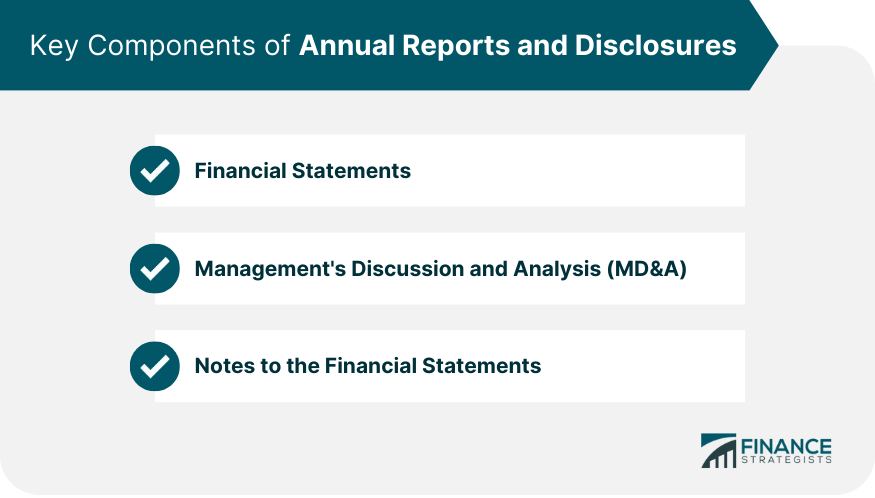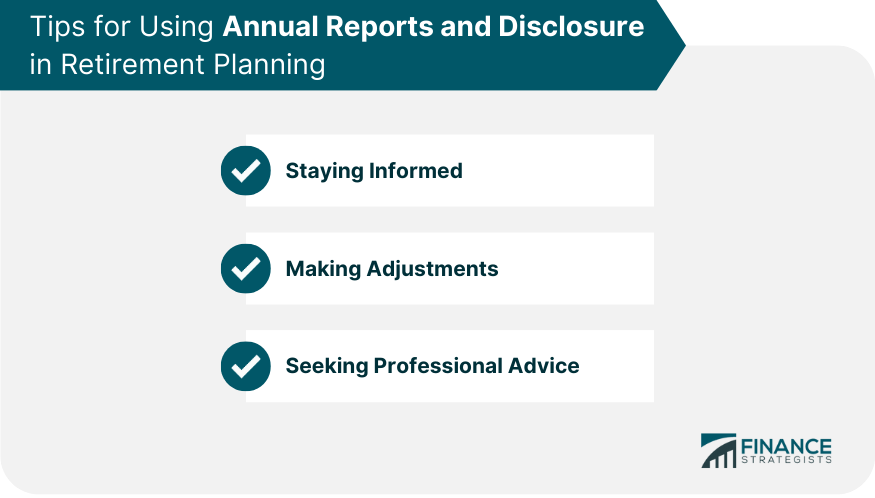Annual reporting and disclosure refer to the process of providing essential financial information and other relevant data about a company, organization, or financial product, such as a retirement plan, to stakeholders, regulators, and the public. This information is typically presented in the form of annual reports, which include financial statements, management's discussion and analysis (MD&A), and notes to the financial statements. These reports aim to offer transparency, ensure compliance with regulatory requirements, and help stakeholders make informed decisions. In the context of retirement planning, annual reporting and disclosure are crucial for understanding a retirement plan's financial health, investment performance, and overall stability. Regulatory bodies like the Securities and Exchange Commission (SEC), Employee Retirement Income Security Act (ERISA), Internal Revenue Service (IRS), and Department of Labor (DOL) enforce various reporting and disclosure requirements to maintain transparency and protect the interests of plan participants. The SEC enforces several regulations that mandate annual reporting and disclosure for publicly traded companies and some retirement plans. ERISA establishes reporting and disclosure requirements for private-sector retirement plans. Some key requirements include providing participants with an annual funding notice about the plan's funding status and a summary annual report that furnishes participants with a summary of the plan's financial condition. The Internal Revenue Service requires retirement plans to file Form 5500, which provides information on the plan's financial condition, investments, and operations. The Department of Labor enforces regulations related to retirement plan administration, including rules on annual reporting and disclosure. Defined benefit plans promise participants a specific monthly benefit at retirement. These plans' annual reporting and disclosure requirements include Pension Benefit Guaranty Corporation (PBGC) premium filings, and actuarial valuation reports that provide information on the plan's funding status and actuarial assumptions. Defined contribution plans, such as 401(k), 403(b), and 457(b) plans, as well as Individual Retirement Accounts (IRAs), base retirement benefits on the participant's account balance. These plans' annual reporting and disclosure requirements typically include Form 5500 and other ERISA-mandated disclosures. The balance sheet provides a snapshot of the plan's assets, liabilities, and equity at a specific point in time. The income statement shows the plan's revenues, expenses, and net income or loss over a specified period. The cash flow statement details the plan's cash inflows and outflows from operating, investing, and financing activities. Lastly, the statement of changes in equity reports changes in the plan's equity, including contributions, investment gains or losses, and benefit payments. The MD&A provides an overview of the plan's financial performance and any significant events that affected it during the reporting period. This section also discusses potential risks and uncertainties that could impact the plan's future performance and provides insights into the plan's prospects, including any anticipated changes to investments, funding, or benefits. These notes explain the plan's accounting principles, methods, and estimates used to prepare the financial statements. They may also include information about events that significantly impacted the plan's financial position, such as changes in plan design or amendments, and disclose any potential liabilities that may arise depending on the outcome of uncertain future events. The funded ratio compares the plan's assets to its liabilities, providing insight into its financial health. Unfunded liabilities occur if the plan's liabilities exceed its assets, which may affect its ability to pay promised benefits. Annual reports disclose the plan's investment returns, which can help participants assess the plan's performance relative to benchmarks or other plans. The plan's investments are typically divided among various asset classes, such as stocks, bonds, and cash. Understanding the plan's asset allocation can help participants gauge the plan's risk profile and diversification. Administrative fees cover the plan's costs, such as recordkeeping, legal, and accounting services. Investment management fees are charged by the investment managers who oversee the plan's assets. When evaluating retirement plan providers, consider their reputation for delivering quality service, investment options, and performance. Assess the variety and quality of investment choices offered by the provider, and compare the provider's fees and expenses with industry benchmarks and competitors. Benchmarking lets you compare the plan's performance, fees, and expenses with industry benchmarks or similar plans. Evaluate the plan's historical performance to identify any trends or fluctuations in performance. Stay current on your retirement plan's performance, fees, and other important information by regularly reviewing annual reports and disclosures. Monitor your plan's investment returns and compare them to benchmarks or other plans to ensure your retirement goals remain on track. Periodically review and adjust your portfolio to maintain your desired asset allocation and risk tolerance. Evaluate your risk tolerance as you approach retirement and adjust your investments accordingly. Consult with a financial advisor to review your retirement plan and provide personalized advice based on your financial goals and risk tolerance. Seek the guidance of retirement plan consultants to review your plan's performance, fees, and compliance with regulatory requirements. Annual reporting and disclosure are crucial elements in retirement planning, as they provide valuable insights into a plan's financial health, investments, and performance. Understanding regulatory requirements from organizations like the SEC, ERISA, IRS, and DOL is essential for compliance. It is important to be familiar with the reporting and disclosure requirements for different retirement plan types, such as defined benefit and defined contribution plans. Evaluating key components of annual reports, including financial statements, MD&A, and notes to the financial statements, can help you assess your plan's funding status, investment performance, and expenses. Comparing and benchmarking annual reports and disclosures can guide you in selecting the right retirement plan provider. Staying informed, making adjustments, and seeking professional advice are vital steps to ensure your retirement planning remains on track. You can make informed decisions and secure a stable financial future by actively monitoring your plan's performance and leveraging annual reports and disclosures.What Is Annual Reporting and Disclosure?
Regulatory Requirements and Standards for Annual Reporting and Disclosure
Securities and Exchange Commission (SEC) Regulations
The primary forms required are the annual Form 10-K, which provides a comprehensive summary of a company's financial performance, and the quarterly Form 10-Q, which contains unaudited financial statements and updates on a company's financial performance between 10-K filings.Employee Retirement Income Security Act (ERISA) Requirements
Other Applicable Regulations
Retirement Plan Types and Annual Reporting and Disclosure
Defined Benefit Plans
Defined Contribution Plans
Key Components of Annual Reports and Disclosures
Financial Statements
Management's Discussion and Analysis (MD&A)
Notes to the Financial Statements

Understanding Annual Report Disclosures for Retirement Planning
Plan Funding Status
Investment Performance
Plan Expenses
Evaluating Retirement Plan Providers with Annual Reporting and Disclosure
Factors to Consider
Comparing Annual Reports and Disclosures
Tips for Using Annual Reports and Disclosure in Retirement Planning
Staying Informed
Making Adjustments
Seeking Professional Advice

Conclusion
Annual Reporting and Disclosure FAQs
The purpose of annual reporting and disclosure is to provide shareholders, investors, regulators, and the public with a comprehensive overview of a company's financial performance, business activities, and management strategies for the past fiscal year. It enhances transparency, accountability, and informed decision-making.
Key components of a company's annual reporting and disclosure documents typically include the financial statements (balance sheet, income statement, cash flow statement), management's discussion and analysis (MD&A), corporate governance information, executive compensation details, auditor's report, and any other relevant disclosures required by regulatory authorities.
Public companies are subject to strict annual reporting and disclosure requirements mandated by securities regulators (e.g., the SEC in the United States). They must file their annual reports with these regulators. Private companies, on the other hand, have fewer reporting and disclosure obligations and are not required to disclose their financial information publicly, though they may still have reporting requirements to certain stakeholders (e.g., lenders, investors).
For publicly traded companies, annual reporting and disclosure documents are typically available on the company's investor relations website. Additionally, these documents can be accessed through the SEC's EDGAR database in the United States. For private companies, access to annual reporting and disclosure documents may be limited to authorized stakeholders.
Companies that fail to comply with annual reporting and disclosure requirements may face regulatory penalties, fines, and sanctions. Non-compliance can also result in reputational damage, loss of investor confidence, and potential legal action from shareholders or other stakeholders. In severe cases, non-compliant companies may be delisted from stock exchanges.
True Tamplin is a published author, public speaker, CEO of UpDigital, and founder of Finance Strategists.
True is a Certified Educator in Personal Finance (CEPF®), author of The Handy Financial Ratios Guide, a member of the Society for Advancing Business Editing and Writing, contributes to his financial education site, Finance Strategists, and has spoken to various financial communities such as the CFA Institute, as well as university students like his Alma mater, Biola University, where he received a bachelor of science in business and data analytics.
To learn more about True, visit his personal website or view his author profiles on Amazon, Nasdaq and Forbes.















